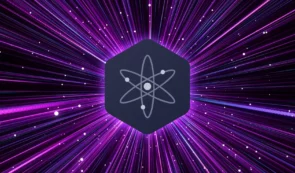What is Cosmos
Cosmos (ATOM) is a decentralized ecosystem of independent blockchains. Its creator hopes it is the foundation for the next generation of Internet technology.
Rather than participating in the divisions between cryptocurrencies, Cosmos brings them together, enabling interoperability, currency exchange, and the Internet of Blockchain (IoB). In other words, Cosmos is an ecosystem of blockchain networks that can scale and interact with each other.
Cosmos has been used for CBDC pilots, stablecoin transfers, and by US-based payment banks.
Atom (ATOM) is the network token used by the network for staking as well as transaction tokenization.
ATOM should not be confused with the abandoned Atomic Coin (ATOM) project. It is the primary cryptocurrency on the Cosmos platform, designed to facilitate communication, scaling, and interoperability between independent chains.
History of Cosmos (ATOM)
In 2014, Jae Kwon applied Byzantine fault tolerance (BFT) research in the context of a public blockchain proof-of-stake (PoS) system and founded Tendermint Inc.
In 2015, Ethan Buchman joined Kwon in developing Tendermint. Tendermint began initial software development, and in 2016 Cosmos became a reality. The Cosmos hub went live on March 13, 2019.
The Interchain Foundation (ICF) supports the development of Cosmos. ICF is a Swiss non-profit foundation created to support the development of Cosmos and the ecosystem contributing to the Cosmos network, which was built by over 15 companies.
The team built this product thanks to two components to make this happen: Tendermint Core and the Inter-Block Communications (IBC) protocol. Together they form the Cosmos Network.
How does Cosmos work?
The main purpose of the Cosmos network is to transfer transfers from one smart contract to another. Suppose person X wants to send 10 ETH from blockchain A to blockchain B. The coins are first deposited in chain A and locked with the proof of validation sent to chain B.
Chain B then verifies that more than two-thirds of the validators on Chain A have validated the locked sum. After this confirmation, person X’s 10 ETH are unlocked and are now available on chain B in any decentralized application (dApp) chosen by X. For this interoperability process to work reliably, Cosmos relies on three key technologies:
- Tendermint Core (TC): the open source base layer that acts as a blockchain development platform. Anyone with an application can use this blockchain embedding to integrate their own decentralized/shared network and their own BFT-compatible consensus model.
- Cosmos SDK: Cosmos Software Development Kit is a set of open-source tools for creating decentralized applications (dApps). Additionally, developers can use the Cosmos SDK to build sovereign blockchain applications called zones that serve as smart contracts instead of relying on single L1 chains. In this way, it is possible to create an interconnected zone hub that powers the cross-chain interoperability of Cosmos. Called the Cosmos Hub, the connected zones themselves do not interact with each other but through the central Cosmos Hub.
- Inter-Blockchain Communication Protocol (IBC) – The next layer is the interconnection layer, which enables the communication between all the individual chains. It is the key layer for exchanging blockchain tokens, data, and digital assets. This creates a series of interconnected zones and hubs that operate independently but share a common system architecture.
Cosmos integrates processing/verification centers to make everything work together. Hubs use the Proof of Stake (PoS) consensus mechanism to validate Tendermint transactions. The project has gained traction in recent years, thanks in part to $9 million in funding from Paradigm and Bain Capital.
